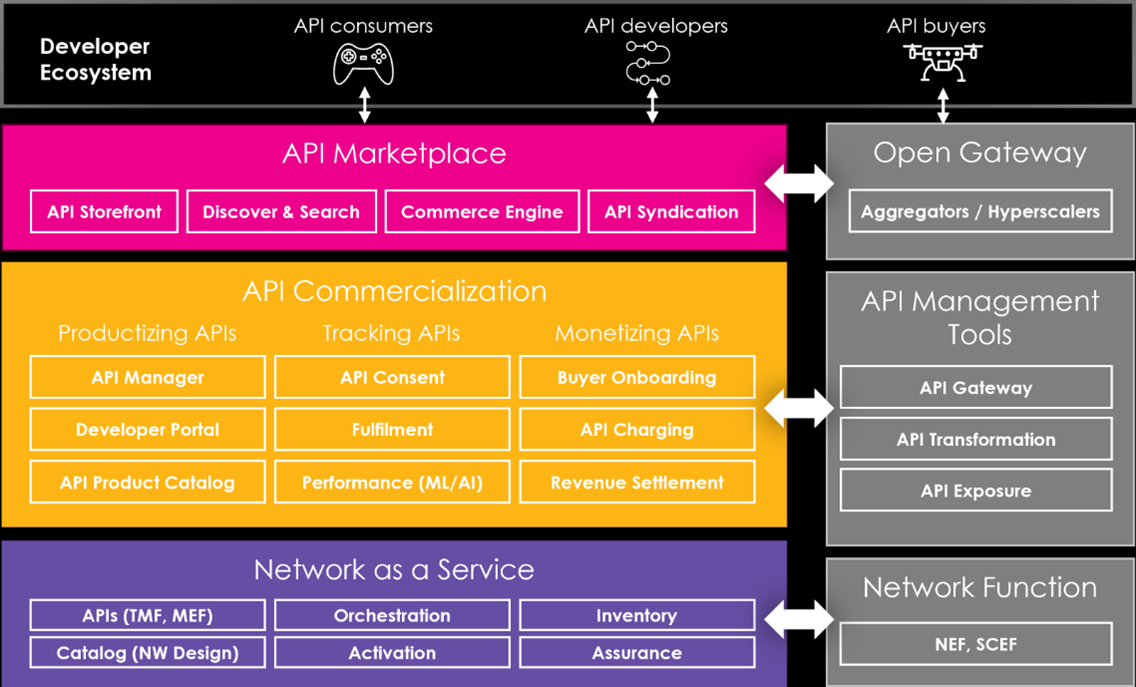Most large-scale tech players have already trialed taking APIs to market – with the most eager creating “pop-up” type marketplaces alongside their core business lines. Yet it’s only over the past 18 months that we’ve seen widespread industry recognition of their actual business value.
This is mostly due to two key factors: advances in exposing discrete network services brought about by 5G, and the standardization of APIs by bodies like CAMARA to facilitate improved integration and utility.
Still, many CSPs remain cautious around the ability to scale and grow revenue around APIs – largely due to the complexity of how APIs are operationalized and monetized at scale. CSPs are responding by looking beyond technical goals, and towards structured approaches that can productize and orchestrate APIs to both drive market momentum and overcome revenue limitations.
Let’s explore the three keys to turning APIs into revenue generators.

Productizing APIs
APIs, like any other product, require a framework to manage the various aspects of going to market. To optimize the business, CSPs need to address both revenue and performance. This means understanding how each API product is orchestrated across channels and charged for based on behavior – from onboarding and fulfilment to charging, syndication, performance monitoring (AI/ML) and consent compliance control.
Then, as API portfolios expand, they need to track and control consent compliance to ensure commercial success. But to achieve complete transparency around data use, this needs to extend beyond basic monitoring and regulatory compliance, while maintaining simple integration paths for developers. Also crucial is the ability to proactively track API performance and usage so that charging models can be adjusted as consumption patterns evolve.
Embracing NaaS as a game changer
Network-as-a-Service (NaaS) transforms how third parties access network services, enabling CSPs to tap into robust infrastructure without the complexity and cost of building their own networks. While to date, most NaaS initiatives have been internal efforts by CSPs to simplify the "operational spaghetti" of in-house IT systems and realize process efficiencies, NaaS presents a promising opportunity to monetize networks in novel ways while revolutionizing how network services are orchestrated and delivered. Analysys Mason, in their recent report, highlights this essential role.
When it comes to bringing APIs to market, NaaS also provides a mechanism for simplifying and automating the operational complexity inherent in orchestrating exposed services. Essentially, by incorporating NaaS into the API enablement framework, this complexity is removed, allowing CSPs to expose network capabilities as readable and consumable features for downstream application developers.
Supporting new commercial models
Since traditional billing and charging models no longer apply, APIs present a unique monetization hurdle. Rather than selling an unlimited plan, it’s now about selling a technical product with a host of different charging variables.
To handle this complexity, APIs need an entirely new charging approach that’s fundamentally responsive and dynamic due to the implicit variation in what’s being charged for and who’s being charged. Examples include the call quantity to each API, defined period of use, bytes moved, outcome-based charges, subscriptions, and percentage-based revenue sharing. And multiply this by the sheer number of APIs that need to be supported in parallel, each with differing conditions.
While 5G and CAMARA have helped overcome the initial technical hurdles ofin making APIs marketable, before CSPs can transform APIs into a sustainable revenue stream, these three keys need to be addressed. By combining smart productization, NaaS integration, and scalable charging models, CSPs can build a framework that not only transforms network capabilities into revenue generators but does so across all channels.











